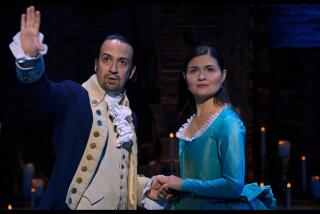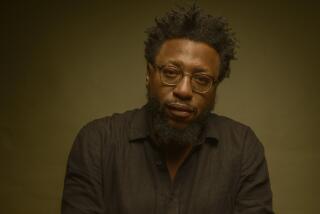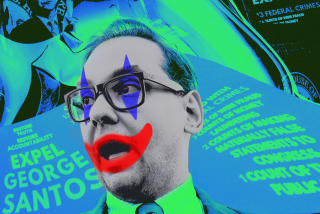Monologuist Offers a Telling Look at History
Looking for an antidote to spin doctors and political pundits who confuse you with fractured facts and doomsday predictions? George Stuart gives a fresh perspective on the American presidency.
Whether heâs presenting a monologue at the Ventura County Museum of History and Art or holding court at his Ojai Gallery, thereâs no confusing what Stuart thinks.
At the museum, where his trademark, one-quarter scale Historical Figures--serve as a dramatic backdrop, Stuart is the consummate performer. Tall and silver-haired, dressed in black, he sits on a high stool and mesmerizes the audience for nearly two hours using only his voice. He doesnât lean on props like Will Rogerâs lariat or Mark Russellâs piano.
Itâs just the monologuist (when he says the word, it rhymes with ecologist) and history.
On a recent Friday evening, Stuart--a self-described âstudent of historyâ--gets the Elderhostel crowd worked up over presidential debates, castigating âthe two bozos in the two partiesâ for excluding Ross Perot.
To scattered applause, he thunders, âWrite your congressman!â With that, he launches into the eveningâs topic: the American presidency from 1789 to 1865.
Informative as well as lively, Stuart provides telling glimpses of our past presidents, some of them less than flattering. George Washington, for instance, was a paternalist who believed that he and his cabinet should rule the country. They considered declaring him king.
*
Alexander Hamilton and Thomas Jefferson didnât think the vote should be trusted to the common man; better to let the moneyed few decide what was best for the masses. And thumbs down to Andrew Jackson for introducing the spoils system.
âThis is why we have such an inefficient government. Everybody brings in their pals,â Stuart says in a momentary nod to the present. Then he resubmerges into past presidential facts, little-known or forgotten.
James Monroe was the most popular elected president, after George Washington. Andrew Jackson hated American Indians. Jefferson was an isolationist. Madison declared war with Great Britain. The Continental Congress was powerless to resolve disputes between the states, and its first delegates were white middle-age males with wealth.
While a dim view of humanity characterizes most of Stuartâs observations, his sardonic wit softens the edge. But woe to those hapless souls who think their vote doesnât matter.
âI really feel very strongly that anybody who doesnât exercise their right to franchise should be stripped naked and flogged on a Saturday afternoon,â Stuart says emphatically. Then, with a sly smile, he adds, âUnfortunately, a good number of the same people who are ignorant and donât know how to vote might cancel my wonderfully enlightened one.â
Stuartâs refreshingly candid and sometimes outrageous views are offered with a cup of tea in the living room of his Ojai Gallery on a tranquil Saturday afternoon. His figures are housed inside the gallery at the far end of a long, screened porch. Open to the public from 1-4 p.m. Saturdays and Sundays, no visitors wander in this day. Itâs easy to miss the turn-off to the gallery if youâre not paying attention to the signs.
Capturing the essence of George Stuart can be equally disorienting. Describe him as an artist, historian or scholar, and he debates the terms. Heâs been described as a renaissance man, autocratic, iconoclastic, brilliant, formal and intimidating. Add charming to that list--at least if you avoid asking him inane questions.
A conversation with Stuart, while focusing on the presidency, meanders down other roads, but his asides are worth the trip. Example: military leaders.
âMost of our generals today are political. Look at Colin Powell. Heâs the personification of a white black man and has all of the attitudes that make white America comfortable,â Stuart says. Powell, like Eisenhower in the 1950s, was courted by both parties, but Stuart shrugs that off as inconsequential. âIn essence, both parties are so identical today, you canât tell one from the other.â
*
There is no true opposition in Washington today, not between the parties and certainly not between the president and Congress. But the posturing of politicos is of little interest to a working-class family in America, says Stuart. If a candidate promises them upward mobility, heâll get their vote.
The outcome of the November election seems to be a foregone conclusion. He sees Clinton reelected.
âPresident Clinton is a far more attractive and entertaining candidate than Robert Dole, even with his presumed sins. Doleâs sins are not that entertaining,â Stuart says.
âIâd be much happier if Mrs. Clinton and Mrs. Dole were running, rather than the men theyâre married to. One is a tired old man whoâs gone with every cretinous lobbyist imaginable, and the other one is a climber, very brilliant and terribly attractive, but obviously willing to do anything to get up the ladder.â
The struggle to get up that ladder isnât nearly so interesting to Stuart as what the climbers do once they get there. Power, its uses and abuses, is a topic that continually intrigues him.
He says all of our presidents have abused power in one way or another. Lincoln declared martial law during the Civil War. Jefferson agreed to the Louisiana Purchase without consulting Congress. If these men were some of our nationâs greatest leaders, should voters even worry about the accusations slung about in the current presidential campaign?
Few presidents have done terrible harm, Stuart says, but in the big picture of American history, it doesnât matter, so donât worry. âAlmost everything will be insignificant in the long run. History rolls on and even ecological wounds heal,â he says. He sees the presidency in a context more broad than contemporary political issues.
âThe president is the traditional symbol of unity. He can no longer function both as a symbol of unity and a political animal,â he says. âWe need a national symbol, somebody who can be above the political party mongers, and can call the nationâs attention to important issues, rally the public.â
Sounds like no earthling in the foreseeable future, but Stuart says that a strong personality can move the masses--if not mountains. Franklin D. Roosevelt helped guide the country through the Depression, and Lincoln managed to keep it from totally unraveling in its most divisive years. Both had that magical attribute--charisma--though it might not have been fully appreciated during their tenure in the Oval Office.
He postulates what Lincoln might do if he were in office today. âLincoln was very savvy. He knew his frontier drawl and the rest of his strange appearance played in his favor so heâd probably use those to enhance a persona,â Stuart says.
âThe little folk at the bottom want to see their leaders in two lights--one as saviors and the other as people just like themselves.â He concludes that Lincoln would probably win the popularity vote today, especially with his gift for words and well-developed sense of humor. The depression that dogged him most of his life might even lift in todayâs Prozac society.
âLincoln was obsessed with death, had his son Tadâs coffin opened twice over a monthâs period of time. He had what I think was a nervous breakdown, couldnât do anything for over a week,â says Stuart.
At one point, he says Lincoln disappeared for almost a week, even tried to get a job in South America. Even if heâd escaped John Wilkes Boothâs bullet, Lincoln probably wouldnât have survived a second term. All this will be among the material Stuart discusses in his museum monologue for December, âLincoln: Up Close.â
*
Though his awe-inspiring figurines have brought Stuart international recognition, he first designed them to illustrate his historical talks. His collection of more than 300 life-like figures are painstakingly crafted; he read autopsy reports looking for possible warts or blemishes. Still, if he had to to do over again, his lifeâs work would be different.
âIn our society it is just totally the wrong thing to do and exist with any tranquillity. Our society is based on advancement. It is a society not interested in the arts, and any kind of artistic endeavor struggles to survive,â he says.
Anyway, heâs not an artist, he says. He doesnât have the instincts of an artist, and has nothing in common with artists. Still, the debate among collectors and curators about whether his three-dimensional portraits are âartâ is a painful one for him.
âThe Historical Figures were never designed to be sold,â Stuart says. But heâs creating new figures on commission. As he puts it, he hasnât gone blind yet, so heâll keep on working.
Stuartâs admirers will be relieved to know he also plans to continue telling stories culled from centuries past. Heâll offer them every month as his exhibits rotate at the Ventura County Museum of History and Art.
And once in a while a piece of historical gossip will color how we look at the present. Imagine a King Clinton or King Dole. Good thing George Washington never pushed that agenda forward.
DETAILS
* WHAT: Monologues by George Stuart.
* WHERE: The Ventura County Museum of History and Art, 100 E. Main St., Ventura.
* WHEN: âThe Founders,â 7:30 p.m. Nov. 8 and 22 and 1:30 p.m. Nov. 12. âLincoln: Close-Up,â 1:30 p.m. Dec. 3 and 7:30 p.m. Dec. 13.
* HOW MUCH: $5 for museum members; $7.50 for nonmembers.
* CALL: 653-0323, Ext. 10 for reservations.
More to Read
The biggest entertainment stories
Get our big stories about Hollywood, film, television, music, arts, culture and more right in your inbox as soon as they publish.
You may occasionally receive promotional content from the Los Angeles Times.










